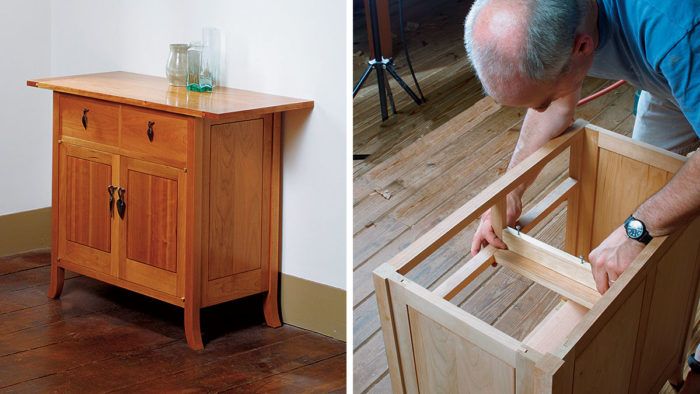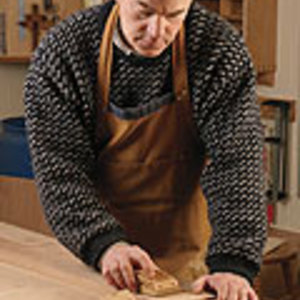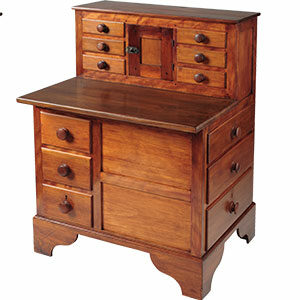An Everyday Cabinet
Straightforward construction methods for building a case with doors and drawers
Synopsis: This small cabinet can be built quickly and with a minimum of materials and knife-hinge hardware. The sides and back are frame and panel with frame stiles biscuited to the legs, and the rest of the joinery, other than the drawers, is mortised and tenoned. Among its fancy elements are slightly flared feet, which are easy to replicate using a template, and knife-hinge hardware. A detailed project plan and step-by-step construction sequences of building the various components tell the story.
When I set up an office and began working at home, I vowed to be careful with what little space I had. But before long I was awash in all of the junk any office accumulates— pencils, notebooks, phone books—and not enough storage room. Part of the solution was this small, shallow cabinet, which tucks beneath a window without blocking the view. Its two drawers offer useful storage, and the lower compartment is unobstructed by a center door divider.
I wanted to build the cabinet quickly and with a minimum of materials. The sides and back are frame and panel with frame stiles biscuited to the legs. That makes for a sturdy carcase that is easy to put together. With the exception of the drawers, the rest of the joinery is mortise and tenon.
The bottom of a table or cabinet leg can be hard to get right. This cabinet is boxy to start with, and I thought a straight leg would be too plain. In Wallace Nutting’s Furniture Treasury (Macmillan Publishing Co., 1933), I found drawings of several legs that meet the floor in a graceful curve. The one I liked the most was a tall clock foot with Hepplewhite origins.
The cabinet’s design is adaptable. It would be easy to alter the height of the drawers or even the overall dimensions of the cabinet without changing its look very much. Figured veneer door panels or drawer fronts would give the piece a much more formal feel. In the end, I kept the design simple.
A template helps with the legs
It’s easier to lay out and shape a template than it is to measure and duplicate the same pattern on four separate legs. I used scrap pine for this template, marking the sweep of the foot with a French curve and noting the locations of mortises for the front frame pieces. These legs curve in only one plane, away from the case sides.
The tip of the foot extends about 3 ⁄4 in. beyond the side of the cabinet, so there really isn’t much waste in cutting the legs from solid wood. Most of the cutting can be done on a tablesaw by running the leg blank through the blade until the kerf just reaches the start of the curve. Mark the extent of the blade’s reach on the fence before you start so that you know how far to go before turning off the saw. A bandsaw will finish the cuts, and a rasp, file and scraper quickly remove the saw marks.
From Fine Woodworking #152
For the full article, download the PDF below:
Fine Woodworking Recommended Products


Sketchup Class

Stanley Powerlock 16-ft. tape measure






















Comments
Like the cabinet, but not crazy about the flared legs. Personal preference. Looks easy to build.
would love to buy the plans. link is broken.
Sorry, they're not available anymore.
Darn, I wanted to buy them too.
Log in or create an account to post a comment.
Sign up Log in